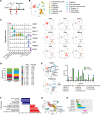Endothelial to mesenchymal Notch signaling regulates skeletal repair
- PMID: 38781018
- PMCID: PMC11383173
- DOI: 10.1172/jci.insight.181073
Endothelial to mesenchymal Notch signaling regulates skeletal repair
Abstract
We present a transcriptomic analysis that provides a better understanding of regulatory mechanisms within the healthy and injured periosteum. The focus of this work is on characterizing early events controlling bone healing during formation of periosteal callus on day 3 after fracture. Building on our previous findings showing that induced Notch1 signaling in osteoprogenitors leads to better healing, we compared samples in which the Notch 1 intracellular domain is overexpressed by periosteal stem/progenitor cells, with control intact and fractured periosteum. Molecular mechanisms and changes in skeletal stem/progenitor cells (SSPCs) and other cell populations within the callus, including hematopoietic lineages, were determined. Notably, Notch ligands were differentially expressed in endothelial and mesenchymal populations, with Dll4 restricted to endothelial cells, whereas Jag1 was expressed by mesenchymal populations. Targeted deletion of Dll4 in endothelial cells using Cdh5CreER resulted in negative effects on early fracture healing, while deletion in SSPCs using α-smooth muscle actin-CreER did not impact bone healing. Translating these observations into a clinically relevant model of bone healing revealed the beneficial effects of delivering Notch ligands alongside the osteogenic inducer, BMP2. These findings provide insights into the regulatory mechanisms within the healthy and injured periosteum, paving the way for novel translational approaches to bone healing.
Keywords: Bone biology; Growth factors; Orthopedics.
Figures






Similar articles
-
CD90's role in vascularization and healing of rib fractures: insights from Dll4/notch regulation.Inflamm Res. 2024 Dec;73(12):2263-2277. doi: 10.1007/s00011-024-01962-w. Epub 2024 Oct 26. Inflamm Res. 2024. PMID: 39455438 Free PMC article.
-
Sequential Ligand-Dependent Notch Signaling Activation Regulates Valve Primordium Formation and Morphogenesis.Circ Res. 2016 May 13;118(10):1480-97. doi: 10.1161/CIRCRESAHA.115.308077. Epub 2016 Apr 7. Circ Res. 2016. PMID: 27056911
-
Modulation of Notch1 signaling regulates bone fracture healing.J Orthop Res. 2020 Nov;38(11):2350-2361. doi: 10.1002/jor.24650. Epub 2020 Mar 16. J Orthop Res. 2020. PMID: 32141629 Free PMC article.
-
Periosteal Skeletal Stem and Progenitor Cells in Bone Regeneration.Curr Osteoporos Rep. 2022 Oct;20(5):334-343. doi: 10.1007/s11914-022-00737-8. Epub 2022 Jul 13. Curr Osteoporos Rep. 2022. PMID: 35829950 Review.
-
Origin of Reparative Stem Cells in Fracture Healing.Curr Osteoporos Rep. 2018 Aug;16(4):490-503. doi: 10.1007/s11914-018-0458-4. Curr Osteoporos Rep. 2018. PMID: 29959723 Free PMC article. Review.
Cited by
-
Effects of aging on the immune and periosteal response to fracture injury.Bone. 2025 Sep;198:117524. doi: 10.1016/j.bone.2025.117524. Epub 2025 May 15. Bone. 2025. PMID: 40381878
-
HIF1 activation safeguards cortical bone formation against impaired oxidative phosphorylation.JCI Insight. 2024 Aug 1;9(18):e182330. doi: 10.1172/jci.insight.182330. JCI Insight. 2024. PMID: 39088272 Free PMC article.
-
Adipose-derived stem cell exosomal miR-21-5p enhances angiogenesis in endothelial progenitor cells to promote bone repair via the NOTCH1/DLL4/VEGFA signaling pathway.J Transl Med. 2024 Nov 8;22(1):1009. doi: 10.1186/s12967-024-05806-3. J Transl Med. 2024. PMID: 39516839 Free PMC article.
-
CD47 is required for mesenchymal progenitor proliferation and fracture repair.Bone Res. 2025 Mar 3;13(1):29. doi: 10.1038/s41413-025-00409-0. Bone Res. 2025. PMID: 40025005 Free PMC article.
-
Endothelial-mesenchymal crosstalk drives osteogenic differentiation of human osteoblasts through Notch signaling.Cell Commun Signal. 2025 Feb 19;23(1):100. doi: 10.1186/s12964-025-02096-0. Cell Commun Signal. 2025. PMID: 39972367 Free PMC article.
References
MeSH terms
Substances
Grants and funding
LinkOut - more resources
Full Text Sources
Molecular Biology Databases

